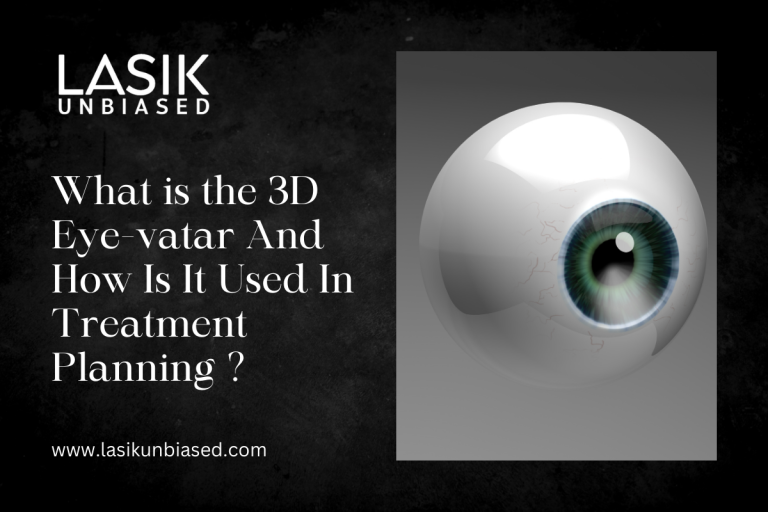The field of ophthalmology has undergone remarkable advancements, especially in laser vision correction and personalized treatments. One of the most innovative technologies recently emerging in this space is the 3D Eye-vatar. This cutting-edge tool revolutionizes how eye care professionals plan and execute treatments for patients with various eye conditions. The 3D Eye-Vatar provides a more personalized, accurate, and practical approach to eye care by combining advanced imaging, artificial intelligence, and detailed patient data.
In this article, we will explore the 3D Avatar, how it works, and how it is used in treatment planning for various eye conditions, as well as remarkably refractive surgery such as LASIK, cataract surgery, and other vision correction procedures.
What is the 3D Eye-vatar?
The 3D Eye-vatar is a sophisticated virtual representation of the patient’s eye, created using highly detailed imaging data from advanced technologies like optical coherence tomography (OCT), topography, and wavefront analysis. These tools capture a 3D model of the eye’s surface and internal structures, allowing for detailed and accurate eye anatomy mapping.
The “Eye-vatar” is similar to the concept of an avatar in gaming or virtual environments, but in this case, it represents the real-time 3D model of the human eye. The 3D Eye-Vatar enables eye care professionals to simulate, assess, and plan treatments with unprecedented precision by creating a digital twin of the patient’s eye.
The Eye-avatar provides valuable insights into the patient’s eye geometry, including:
- The curvature of the cornea
- The shape and depth of the lens
- The health and alignment of the retina
- Optical aberrations and visual distortions
By integrating all this data, the 3D Eye-Vatar gives doctors a highly accurate visual representation of the eye, making it easier to tailor treatment plans that address the patient’s unique needs.
How Does the 3D Eye-vatar Work?
Creating a 3D eye avatar typically involves combining several diagnostic imaging techniques. Here is an overview of how this technology works:
1. High-Resolution Imaging
The creation of the 3D Eye-Vatar begins with capturing high-resolution images of the eye using advanced imaging technologies such as OCT and corneal topography. These devices scan the surface of the eye, the cornea, and the retina, capturing detailed data about their shape and structure.
2. Data Integration and Mapping
Once the imaging is completed, the data is processed and integrated into a 3D eye model. This model accurately represents the various components of the eye, such as the cornea, lens, retina, and optic nerve, and can be visualized from different angles and perspectives.
3. Customization for Individual Patients
Using the patient’s specific measurements and medical history, the 3D Eye-vatar is customized to reflect individual eye structure variations. Factors like corneal irregularities, pupil size, and optical aberrations are all considered.
4. Treatment Simulation
Once the digital 3D model is created, treatment options can be simulated within the Avatar interface. For example, if a patient is undergoing LASIK surgery, the 3D Avatar can simulate how the laser will reshape the cornea. This helps surgeons visualize the potential outcomes and adjust the treatment plan for the best possible results.
5. Real-Time Adjustments and Accuracy
The 3D Eye-vatar also allows for real-time adjustments during the treatment planning phase. Surgeons can modify the treatment plan based on the simulation, ensuring the procedure addresses the patient’s specific needs and minimizes the risk of complications.
How is the 3D Eye-vatar Used in Treatment Planning?
The use of the 3D Eye-Vatar is particularly beneficial in vision correction procedures, as it enables a more personalized and precise approach to treatment. Below are some of how the 3D Eye-avatar is utilized in treatment planning:
1. Refractive Surgery (LASIK and PRK)
In refractive surgery, such as LASIK or PRK (Photorefractive Keratectomy), the 3D Eye-vatar is used to map out the precise topography of the cornea. Surgeons can visualize irregularities in the corneal surface that may affect vision and tailor the laser treatment to address these irregularities.
For example, if a patient has astigmatism or an irregular corneal shape, the 3D Eye-Vatar allows the surgeon to modify the laser’s settings to ensure an accurate correction. This minimizes the risk of post-surgical complications, such as under-correction or overcorrection, and helps achieve optimal visual outcomes.
2. Cataract Surgery
In cataract surgery, the 3D Eye-vatar is crucial in the selection of intraocular lens (IOL). Choosing the correct IOL is essential for achieving clear vision after cataract surgery, and the 3D model allows the surgeon to assess the eye’s size, shape, and optical needs.
Using the 3D Eye-vatar, surgeons can simulate how different IOLs will perform in the patient’s eye, optimizing the selection based on the patient’s unique anatomy. This level of precision helps reduce the chances of visual disturbances such as halos, glare, or poor contrast sensitivity after the surgery.
3. Customizing Treatment for High Astigmatism
In cases of high astigmatism, where the cornea is abnormally shaped, the 3D Eye-Vatar offers an accurate map of the corneal irregularities. Surgeons can use this information to plan a more customized treatment that corrects astigmatism with precision, ensuring that the patient’s vision is as clear and stable as possible post-surgery.
4. Monitoring Post-Surgical Progress
After surgery, the 3D Eye-vatar can also monitor a patient’s healing progress. By capturing follow-up images, doctors can compare the current state of the eye with pre-operative data to ensure that healing is proceeding as expected. This helps make necessary adjustments to the treatment plan and provides the best long-term visual outcomes.
5. Assessment of Optical Aberrations
The 3D Eye-Vatar is valuable for assessing wavefront aberrations, which are distortions in how light enters the eye. These aberrations can cause visual issues such as halos, glare, or poor night vision. By visualizing these distortions in a 3D model, surgeons can develop more effective treatments, such as customized LASIK, that target and correct these specific issues.
Benefits of Using the 3D Eye-avatar in Treatment Planning
The integration of the 3D Eye-avatar into treatment planning offers several key benefits:
1. Enhanced Precision and Accuracy
The 3D eye avatar allows surgeons to plan treatments with high precision. This leads to better surgical outcomes and minimizes the risk of complications, providing patients with more predictable and stable results.
2. Personalized Treatment
Each patient’s eye is unique, and the 3D eye avatar ensures that treatment is customized to the specific characteristics of the patient’s eye. This approach leads to more effective treatment and a higher likelihood of successful outcomes.
3. Improved Patient Communication
The 3D Eye-vatar visually represents the patient’s eye, allowing them to better understand their condition and treatment plan. This can improve communication between the surgeon and the patient and help manage expectations throughout treatment.
4. Reduced Risk of Errors
Allowing surgeons to visualize the eye in 3D and simulate various treatment scenarios significantly reduces the risk of errors during surgery. This can lead to better results and a smoother recovery process.


